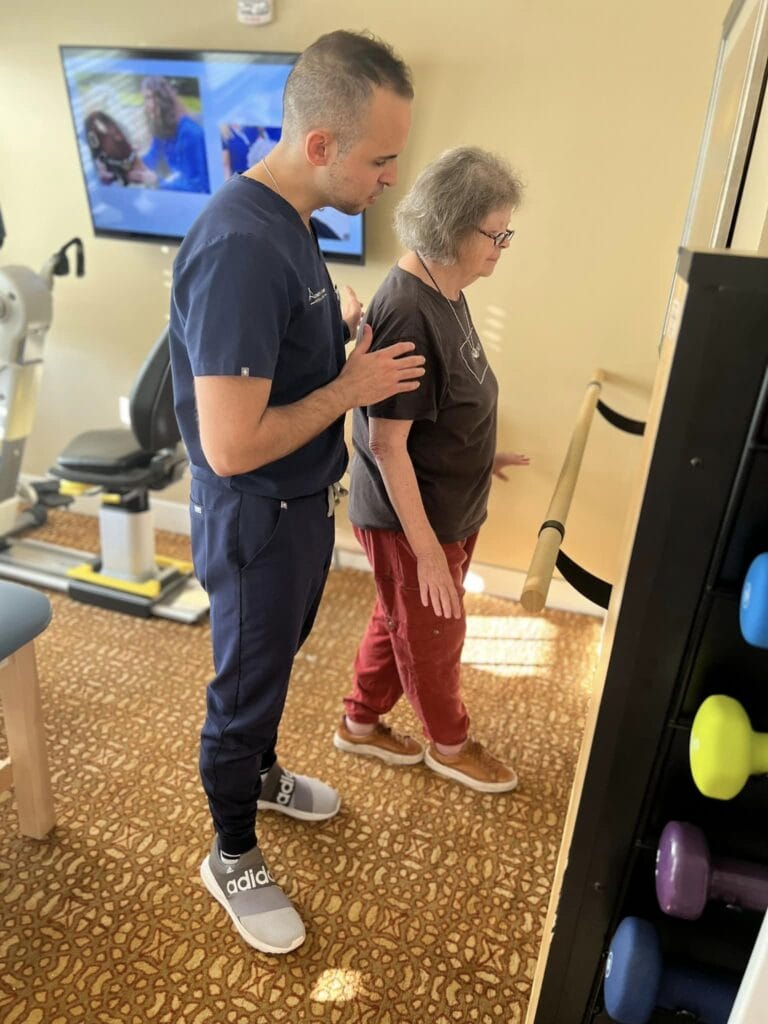Seniors: exercising is crucial as we age. We can empathize, though: as we age, our joints begin to ache, and our bones become more brittle. But how many steps a day should an 80-year-old take?
How are we supposed to know what the right amount of exercise is each day? How many steps should we take each day to ensure optimal health?
Not to worry. Village Walk here.
Our team of senior living professionals has more than 30 years of experience helping seniors live healthy, happy, physically active, and vibrant lives.
If you’re wondering how many steps are needed to live your best life, join us! We’ll cover the recent research on how many steps a senior should walk each day.
Whether you’re 60, 80, or even 100 years old, discover the right number for you. Let’s get a move on!
Conventional wisdom on steps says…

You know the old adage, the one that suggests walking 10,000 steps per day? Research suggests that 10,000 steps may not be the most accurate and up-to-date guideline for seniors.
The truth is that having a number such as 10,000 steps can help us, but may not be the most accurate for each age group. With that said, setting a step count goal can help us move towards more intentional physical activity.
And exercise definitely helps us live longer. Let’s take a look at what up-to-date research says on the recommended steps needed per day.
Recent research in the last decade says…
6,000 to 8,000 steps per day: the Lancet Public Health (2022) found this range helped lower mortality risks for adults sixty years and older.
The sweet spot appears to be 4,500 steps to 7,500 steps for adults 61 and older, according to the Journal of the American Medical Association (JAMA).
JAMA also found that there wasn’t a strong relationship between how intense the steps were and how long a person lived.
Whether you’re walking 6,000 steps or 10,00 steps, both step counts and intensities offer health benefits.
Here’s a more detailed look at each age group:
- 10,000-15,000 steps per day: for youth aged 4-17. The number may depend on many factors, according to a study by the International Journal of Behavioral Nutrition and Physical Activity
- 7,000-10,000 steps per day: for adults aged 18-59 according to various studies, including JAMA Network’s study on middle-aged black and white women and men.
- 6,000-8,000 steps per day: for adults aged 60 and older, according to various research institutions, including a round-up review of research posted by the University of North Carolina’s Gillings School of Global Public Health.
Older adults can reap the health benefits of walking by finding hobbies in retirement that boost physical activity. Engaging in walking programs and wellness programs can all help reduce the risk of coronary artery disease and other cardiovascular diseases.
Even if you don’t have the physical capacity for high-intensity exercise, so long as you’re not walking less than 4,400 steps daily, you can help increase longevity.
The road to a better life really does start with a single step.
Table: number of steps by age
Note: these numbers are an approximation. The exact number that’s best for you will depend on your lifestyle and your healthcare team’s recommendations.
| Age | Number of steps |
| 4-17 years old | 10,000- 15,000 steps per day on average |
| 18-59 years old | 7,000- 10,000 steps per day on average |
| 60 years and older | 6,000- 8,000 steps per day on average |
We walk to end Alzheimer’s!
Each year, #Teamvillagewalk is proud to participate in the East End Alzheimer’s Association walk at the Suffolk Farm. This past year, we even had the opportunity to go for a tractor ride after the walk!
Check out the pictures here!
Seniors: take the first step, and walk with a community
In a nutshell, sedentary individuals who take under 2,700 steps per day are at greater risk for all-cause mortality. In other words, the less you walk, the more likely you are to die from different causes, as morbid as that sounds.
If you’re finding walking challenging, not to worry. Take the first step and increase your step count little by little each day.
Whether you choose to increase your steps through a stroll through the park, a vigorous hike up a mountain, or one of your favorite retirement hobbies, know that you’re never alone.
Our Village Walk community has helped countless seniors to increase their physical fitness. Through physical therapy, health and wellness programs, and daily outings, our assisted living neighborhood community welcomes you to join our active bunch!
Seniors: if you’re looking for a community that prioritizes health and wellness, we can help. Village Walk’s staff have helped seniors move and groove for more than 30 years.
Frequently asked questions (FAQ) about senior health and walking
How many steps should a 60- o 80-year-old take each day?
The research suggests that 6,000-8,000 steps per day can help reduce the risk of all-cause mortality in seniors 60 years or older. No connection was found between the intensity of the steps and how long a person lived.
In other words, the intensity of steps wasn’t related to whether a person died earlier in life.
Why the new research on walking and steps?
It’s true. Many studies suggest that the more steps you take, the less likely you are to develop diseases and physical conditions.
But over the last decade, those numbers have changed.
While the risk of contracting a variety of diseases and conditions may lower, the risk of dying from them may not.
The new research on this topic is important because it suggests that shooting for a range of steps is just as important — if not more important — than meeting a 10,000-step benchmark.
What’s more, each age group has a different range. For these reasons, we thought exploring the new research was important to ensure the well-being of our senior population.
What’s the best way to determine how many steps I should take daily?
With fitness tracking devices like FitBit becoming more and more widespread, you couldn’t have picked a better time to track your daily step count.
We’re blessed to live in a time with so many step-counting devices to keep track of our daily step counts. Whether you choose a fancy pedometer, a sleek and stylish Apple watch, or a fitness tracker on your favorite mobile device, you have options when tracking your daily step goal
Seniors: the best way to determine how many steps you should take each day is by doing a systematic review of the latest research literature, reaching out to your trusted healthcare team, and using tools that help you track your fitness goals.
“They got Mom dancing like a 16-year-old!”
Dad did his dips and high kicks like a Rockette! Some of my best memories with my parents were made here!!!
They got Mom dancing like a 16-year-old, like I’ve never seen! We danced a lot!
Mom had her best, last year here. The Rec team was the highlight.
Melissa on the rec team even had Dad bowling when he couldn’t stand.
I cannot say enough. Go take a tour!!
Talk to the staff, and see for yourself! A blessing! Forever grateful.💝” – Diana G., Grateful Village Walk family member.








